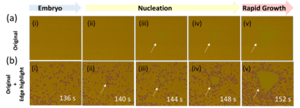PRESS RELEASE
- Research
- 2021
Non-classical nucleation in vapor–liquid–solid growth of monolayer WS2 revealed by in-situ monitoring chemical vapor deposition
Authors
Xiaoming Qiang, Yuta Iwamoto, Aoi Watanabe, Tomoya Kameyama, Xing He, Toshiro Kaneko, Yasushi Shibuta, Toshiaki Kato
Abstract
The very early nucleation stage of a transition metal dichalcogenide (TMD) was directly observed with in-situ monitoring of chemical vapor deposition and automated image analysis. Unique nucleation dynamics, such as very large critical nuclei and slow to rapid growth transitions, were observed during the vapor–liquid–solid (VLS) growth of monolayer tungsten disulfide (WS2). This can be explained by two-step nucleation, also known as non-classical nucleation, in which metastable clusters are formed through the aggregation of droplets. Subsequently, nucleation of solid WS2 takes place inside the metastable cluster. Furthermore, the detailed nucleation dynamics was systematically investigated from a thermodynamic point of view, revealing that the incubation time of metastable cluster formation follows the traditional time–temperature transformation diagram. Quantitative phase field simulation, combined with Bayesian inference, was conducted to extract quantitative information on the growth dynamics and crystal anisotropy from in-situ images. A clear transition in growth dynamics and crystal anisotropy between the slow and rapid growth phases was quantitatively verified. This observation supports the existence of two-step nucleation in the VLS growth of WS2. Such detailed understanding of TMD nucleation dynamics can be useful for achieving perfect structure control of TMDs.

Scientific Reports:https://www.nature.com/articles/s41598-021-01666-9

